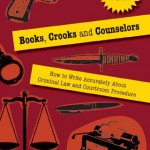I’m republishing here a few of the articles currently on my website before it undergoes a major revision. While I’m not a publishing lawyer, one thing any decent lawyer can do is research, then analyze and synthesize the results. Herewith, those results.
COPYRIGHT BASICS Answers to the most frequent questions about copyright–how to establish it, avoiding infringement, and other issues
(First published in the Sisters in Crime Guppy Newsletter, First Draft, 2004 but still valid)
This month, by request, I’m straying slightly from my mission to provide legal information for use in fiction to discuss the basic principles of copyright law.
What is copyright and what does an unpublished writer need to know? Forget everything you think you know about copyright. In 1978, Congress enacted a new system which has since undergone further changes as a result of both Congressional action and Supreme Court decisions. Yes, 1978 was a while ago, but myths and assumptions take a long time to die. So euthanize yours, and read along with me.
Copyright, at its most basic, is the right to claim ownership of a creative work and earn profit from it. Copy, the word-within-a-word, fools us into thinking copyright pertains only to written works. Copyright principles apply equally to literary works, music (including lyrics), film and sound recordings, paintings, photos, architectural plans, and other works.
You may not copyright ideas, titles, names, phrases, slogans, common symbols (although trademark or service mark registration may be available), or processes (patent protection may be available).
Copyright gives its holder specific benefits. These include the exclusive right to reproduce the work, prepare derivative works (J.K. Rowling’sQuidditch Through the Ages or Harry Potter mugs), distribute the work by sale or license, and perform or display the work publicly. Transfer of ownership does not transfer the copyright unless expressly agreed in writing; an artist who sells a painting still owns the copyright and has the exclusive right to reproduce the painting in prints, posters, cards, t-shirts, or other media.
Copyright arises automatically as soon as a work is created. The work need not be completed or published, but it must be fixed in a medium. For literary work, of course, that means it must be written. You have automatic copyright in your partial outlines, rough drafts, and finely polished final copy. But you have no copyright to an idea or a plot outline kept in your head.
Copyright can be inherited; when an author dies, rights to her work, published or not, go to her heirs.
You don’t need to register your work to obtain copyright. The U.S. Copyright Office says this: “In general, copyright registration is a legal formality intended to make a public record of the basic facts of a particular copyright. However, registration is not a condition of copyright protection.”
You don’t need to use the © symbol to establish copyright. The rule requiring copyright notice on the work has been eliminated for all works published since 1989. The word or symbol does give notice that the work is copyrighted, and thus can help make or defend an infringement claim, but use of the symbol is not necessary to establish copyright. If challenged, you can establish your copyright by showing creation through the work itself, drafts, outlines, journal notations, dates on computer printouts, and personal testimony.
If you use the symbol, the U.S. Copyright Office suggests this format, in a location that gives the reader reasonable notice:
©2004 John Doe
Some writers claim that agents & editors consider a writer who puts the © symbol on her work to be an amateur. I haven’t been able to confirm or rule that out. I have been told that most book publishers prefer that authors not register their work but let the publisher do so at the time of publication; that way, the copyright date inside the book is current and doesn’t cut sales by giving the false impression that a book is older or a reprint.
What are the benefits of registration and how do I register copyright? The chief benefit of registration is to establish a public record and make it easier to establish copyright if someone steals your work or accuses you of stealing hers. Other benefits include protection against illegal importation of unauthorized copies.
Registration requires an application and $30 fee for each work, plus copies for deposit in the Library of Congress. See the U.S. Copyright Office website for specifics and forms.
How long does copyright last? For works created on or after January 1, 1978, copyright lasts for the author’s life plus 70 years after death. For joint authors, copyright lasts 70 years after the last surviving author’s death. In a major change from prior law, copyright may no longer be renewed. You may think this short-changes authors, but the trade-off is that the term of copyright is now considerably longer and copyright holders can no longer inadvertently lose their rights. (Under prior law, copyright was 28 years with a 28 year renewal term, but renewal was not automatic and copyright was lost if not renewed during the original term).
Any work created before 1923 is no longer protected by copyright and has entered the public domain. That means the work can be quoted freely without permission. (You should still give credit, though, to avoid confusing your readers and triggering suspicions of plagiarism.)
Copyright obtained between 1923 and 1978 may be current or may have expired. Check with the U.S. Copyright Office for specifics on the copyright of older works.
What are the risks of sharing my work before publication or registration? Whether sharing work creates a risk of theft depends largely on how and with whom you share. Choose wisely. Submitting work to a reputable agent or editor rarely creates problems. At nearly every writers’ conference or workshop I’ve attended, a novice has expressed concern about theft of an idea; the published writers, agents, and editors uniformly respond that the writer’s concern marks him as an amateur and he should not worry. If you share pages with a face-to-face critique group or an online group in whom you’ve built trust, the risk is probably minimal. Sharing in a less secure environment, such as an online writers’ forum or chat room where you don’t know who is participating, is far riskier. Choose what you share carefully. If you have a concept for a book that’s never been done, it’s probably better to spend your energy writing the book than touting your concept.
Keep in mind that ideas, concepts, and facts cannot be copyrighted. Sometimes an idea is in the air. Maybe you mentioned in the bar at Left Coast Crime your idea for a mystery with a frozen body found in a glacier. The next year, Dana Stabenow published a Kate Shugak mystery in which a receding glacier reveals a dead body. She wasn’t in the bar with you and her book was already in the pipeline. Neither of you stole the idea from the other. Writer Les Standiford, head of the creative writing department at Florida International University, often testifies as an expert in copyright cases involving novelists and screenwriters. He reminds writers that similarities in story structure or overall concept do not mean the story was stolen; the focus in determining theft (copyright infringement) is on content and style — that is, how the writer develops the idea.
How much can I quote without violating copyright? What is fair use? Copyright gives its holder the exclusive right to use a work. However, an exception exists for limited use of quotes without authorization. A long-standing myth says four lines or fifty words can be quoted without fear. Slay that bugaboo now.
The key to determining whether quoting infringes copyright is whether the quoting is “fair.” In the landmark case, Harper & Row v. Nation Enterprises, 471 U.S. 539 (1985), Harper sold Time magazine the right to publish an excerpt from former President Gerald Ford’s forthcoming memoir. The Nationobtained a pre-publication copy and ran an article quoting three hundred words. Time cancelled the deal and refused to pay Harper. In finding againstThe Nation, the United States Supreme Court set out several factors to be considered:
— the purpose and character of the use. Quotation in a review, even if critical, is obviously fair, so long as it is accurate. Quotation for profit, as inThe Nation’s scoop, weighs against fairness.
— nature of the copyrighted work. Are you quoting historical facts or compilations, or fiction or poetry? The more factual and less creative, the more “fair” the use.
— amount and substantiality of use. The Supreme Court held that the 300 word excerpt quoted in The Nation — Ford’s reflections on pardoning Nixon — was the heart of the 200,000 word manuscript. Point: it’s not the length that counts, but what you excerpt and how you use it. Four lines from Crime and Punishment may be insignificant, but four lines from a Langston Hughes poem may be the bulk of it.
— effect on potential market or value. The Nation scooped Time for profit and market share. A reviewer or a professor giving a talk on literary criticism doesn’t have the same negative effect on market.
Bottom line: Think carefully about whether you need to quote a copyrighted work, how you are quoting, and how the copyright holder will view your quote. When in doubt, discuss getting permission to quote with your publisher. Contact the publisher of the work quoted or the Authors’ Registry, a clearinghouse for contacts and payments, or search the Copyright Office database.
Remember that copyright protection doesn’t apply to titles and short phrases. Even though the music and lyrics of “Proud Mary” are still under copyright, you may use the song title as a book title. Most readers will make the connection to “Proud Mary, keep on burning,” especially if a character mentions to John Fogerty or a Creedence Clearwater Revival concert, or if the plot involves a riverboat — or even a woman named Mary. But if you intend to quote the lyrics in the text or as an epigram or a chapter heading, copyright protection applies. Requesting permission in advance is a lot easier than responding to a “cease and desist” letter asserting an infringement claim when your book is already in print. A new author using a short quote in a paperback edition with an average print run may be given permission to quote at no or low cost. If the price is too high, revise to use only a title or an image, not a quote, or to quote only material in the public domain.
Copyright protection also applies to material used in a free publication. Most copyright holders will charge only a nominal fee for non-profit use. You might wonder why a wealthy musician or a Pulitzer prize winner would charge at all in that situation. Charging, even if only ten dollars, helps the copyright holder demonstrate that it is actively protecting its right to control the use of the work, which could be important in an infringement claim where more money is at stake. Remember that copyright law protects the holder’s right to decide how and where the material is used, not just the right to earn profits from the work.
If you’re writing parody, or rap music with sampling, the rules differ. Check them carefully.
What about photocopying? If it’s for your own use, relax. However, copying articles for archival use in a corporate setting is a problem if systematic or institutional; research the practice before continuing it. Brief excerpts for educational use are acceptable, but systematic use or creation of “course packs” for students is not.
(I am indebted to Crawford & Murray, authors of The Writer’s Legal Guide, for their insights into the Harper & Row decision.)
May I use a real play as background in a mystery set in a community theater? May the characters discuss the title, plot, their roles, or the author? Plots and titles can’t be copyrighted, so you can freely use both and let the characters in your novel discuss them. Novel characters may discuss play characters, but you cannot recreate a character from the play in your novel without permission. That is, you can write a novel in which an actor discusses playing John Proctor in “The Crucible,” and you could also write a historical novel featuring John Proctor so long as you based your work on historical research and not on the Arthur Miller play. But if a play is still under copyright, you may not take a character and use him as your own.
Fair use principles apply to quoting. You need permission to quote if you write a scene where characters recite lines from the play while rehearsing. But if your characters simply discuss how they’ll act out the confrontation between John and Mary Proctor without quoting lines from Miller’s play, no permission is needed.
Discussion of the author of the play is regulated not by copyright principles but by the law of libel and slander. The characters in the novel may freely discuss what they think Miller intended in a certain scene or the political context in which he wrote “The Crucible.” They may also discuss the facts of Miller’s own life, so long as they do so accurately. Opinions may be freely given so long as they are clearly opinion; a character may say “In my opinion, Miller’s over-rated” or “I think he was crazy to marry Marilyn.”
In addition to the sources already mentioned, you may be able to contact the copyright holder of plays through Dramatists’ Play Service, which publishes plays and licenses production rights.
Magazine publishers may copyright articles by freelancers as “work for hire.” Magazines commonly copyright an entire issue as one piece of work in the publisher’s name. This avoids the expense and trouble of registering copyright for each story in the name of the magazine (if staff-written) or the freelance writer. Typically, contracts specify that the writer is providing the story as “work for hire,” but has the right to publish the piece on her website, in an anthology, or after a specific period of time, in another publication. Magazine publishers rarely refuse permission to reprint if given credit for the original publication. Magazines often retain the right to publish the piece on its own website or in their own anthologies (e.g., “Sunset Magazine’s Guide to Western R.V. Travel”).
What copyright protection exists internationally? There is no “international copyright;” the laws of individual countries govern. Happily, most countries have signed treaties giving copyright protection to non-citizens, agreeing to enforce each others’ copyright laws, and providing an enforcement mechanism.
Full U.S. copyright protection is available to any person who, when the work is created, is a “national or domiciliary” (meaning generally a citizen or resident) of the U.S. or any country that is a signatory to international copyright treaties. U.S. copyright law also applies automatically to works first published in the U.S. or treaty parties. In short, most countries have signed international copyright agreements and honor copyright no matter what the author’s citizenship or residency.
If your work is first published abroad and you are a U.S. citizen or resident, your copyright is protected by both foreign and U.S. law. The treaties provide a relatively uniform system of protection.
If you sell foreign rights and your work is published in translation or in a different edition (e.g., a book first published in the U.S. is published in German for distribution in Germany or in a British edition with differences in spelling), a separate copyright exists in the new edition.
For more info, check out the U.S. Copyright office for circulars on specific topics or their Frequently Asked Questions. Or consult a legal reference book for writers such as The Writer’s Legal Guide, an Authors Guild Desk Reference, by Tad Crawford & Kay Murray (3d Ed. 2002, Allworth Press). (When I spy a new edition, I’ll raise my hand.)





 Shanna Lisberg
Shanna Lisberg